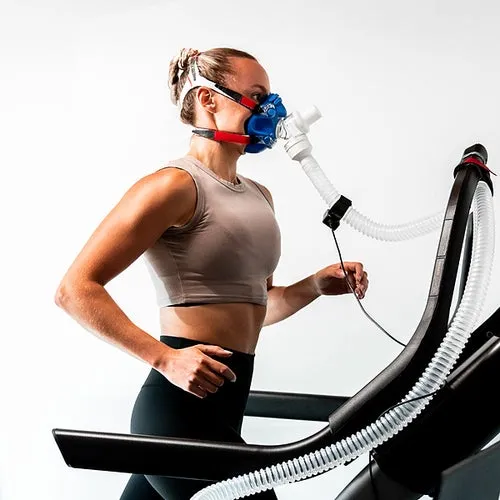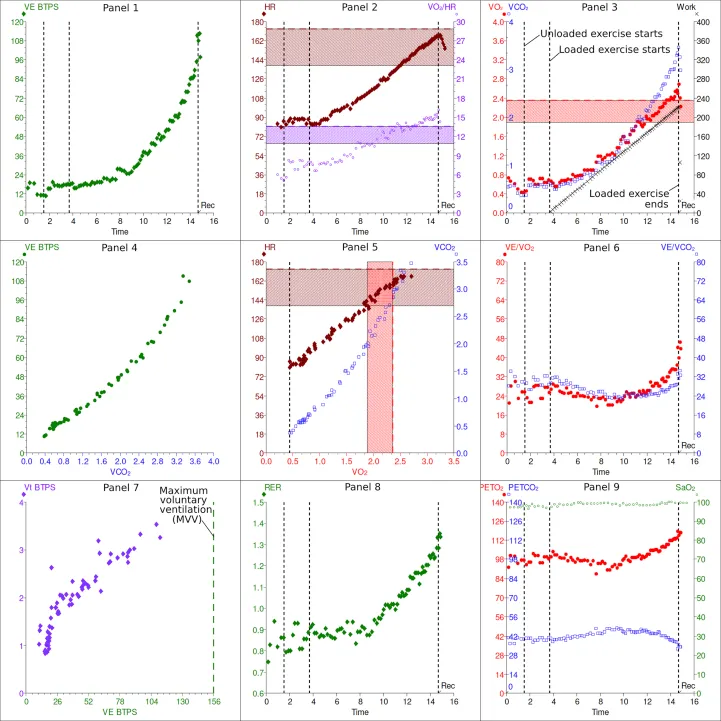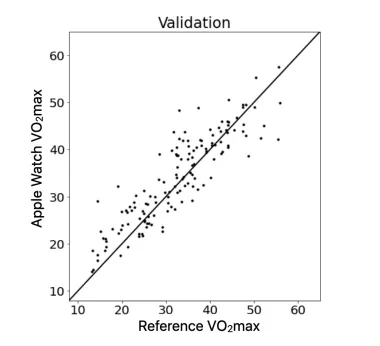VO2Max is a powerful metric of longevity: every 1 ml/kg/min increase in VO2 max reduces risk of death by 9 percent.
When you get a clinical test of VO2Max, you usually have to wear a respiratory mask and exercise on a treadmill or cycle. Your Apple Watch calculates cardio fitness (an estimate of VO2 max) without a mask. And it does it accurately—within 1.2 ml/kg/min. Given that the average VO2max is 29 ml/kg/min, that means Apple Watch estimates VO2Max to within 4% of the true value.
How do they do that? This article explains the science behind VO2 max and how the accuracy of Apple Watch’s cardio fitness algorithm was tested in a study of 755 volunteers. Along the way we’ll cover 9-panel plots used in VO2 max testing, how deep learning is used to estimate cardio fitness, what you can do about low cardio fitness alerts, and limitations of Apple Watch’s VO2Max algorithm for people with certain medical conditions (arrhythmias, pacemakers, skeletal or neuromuscular condition, exercise intolerance, etc).
For details on how to actually use VO2Max, its link to longevity, and how to get a cardio fitness measurement, see our guide to Apple Watch’s cardio fitness metric.
Primer: how VO2Max is measured in the lab
Before we get into how Apple Watch algorithm estimates VO2Max, we have to first define how VO2Max is actually measured in the lab.
VO₂ Max is defined as the maximum volume of O₂ (oxygen) the body can utilize during intense exercise. It’s measured during a cardiopulmonary exercise test (CPET). During a CPET, you wear a respiratory mask while exercising (e.g., cycling or treadmill) at a steadily increasing intensity. As the work intensity rises, you consume more O₂ (oxygen), expell more CO₂ (carbon dioxide), and your heart rate rises.

At some point, the intensity of the workout becomes high enough that your muscles need more oxygen than your heart and lungs can supply. Your muscle cells are then forced to switch from aerobic to anerobic energy production, so that CO₂ continues increasing while O₂ pleateaus. At least, this is the “idealized” test situation—in practice, O₂ may not actually reach a plateau and the test may end when the the ratio of CO₂ to O₂ reaches 1.1, when the patient feels breathless, when an ECG shows signs of stress, etc.
This whole process produces a nine-panel plot, which shows various combinations of O₂ consumed, CO₂ expelled, intensity of exercise (in watts), heart rate, breathing rate, blood oxygen saturation, and so on.

In panel 3, you can see how both O₂ (red) and CO₂ (blue) increase as the exercise intensity ramps up (black). Around 11 minutes, there’s a point where the two lines diverge. This is the anaerobic threshold. Panel 5 shows that heart rate increases roughly in proportion to O₂.
How Apple Watch’s VO2Max estimation algorithm works
Apple Watch estimates VO2Max using just heart rate and GPS signals. While algorithm behind cardio fitness builds on prior medical literature, it’s much more sophisticated than you might expect. Apple Watch’s cardio fitness algorithm combines a physiological ODE (ordinary differential equation) with a deep neural network to estimate VO2Max.
If you want the technical details, we wrote a teardown of How Apple Watch’s cardio fitness algorithm works, based on a 2023 paper by researchers from Apple and Columbia University. The linked blog post requires a bit of background in differential equations and deep learning.
If you just want to know how accurate Apple Watch’s VO2 max algorithm is, or what to do about low cardio fitness notifications, read on.
Accuracy of Apple Watch VO2Max (cardio fitness)
So, is the Apple Watch’s estimate of VO2Max accurate? Yes—within about 4% of the true value. Let’s dive in to how Apple validated the algorithm against actual VO2Max estimates.
Apple Watch’s cardio fitness algorithm was validated in a study with 221 participants
Apple itself ran a study validating the algorithm, with 534 participants for development and 221 for validation (755 total). Apple Watch’s VO2Max estimates were surprisingly accurate, with a reliability coefficient (ICC) around 0.86–0.89.
Chart of Apple Watch VO2Max accuracy
You can see a plot of actual VO2Max (x axis) vs the Apple Watch’s cardio fitness estimate (y axis) below. Apple Watch’s VO2Max is accurate to within 1.2-1.4 ml/kg/min, or 4%, of the true value.

Limitations of Apple Watch’s VO2Max estimates
However, the algorithm does have limitations for people with certain health conditions and on certain medications. Here are some limitations from Apple’s own report:
Other medical conditions can also decrease the accuracy of VO2 max estimates on Apple Watch. These include medical conditions or devices that decouple heart rate from movement or exercise (for example, pain, arrhythmias, pacemakers, or cardiac-assist devices); medical conditions that severely limit exercise tolerance, preventing patients from reaching heart rates close to their predicted maximum heart rate (for example, peripheral arterial disease); and medical conditions that significantly increase the difficulty of ambulation, such as skeletal or neuromuscular conditions causing gait inefficiency (for example, multiple sclerosis or cerebral palsy).
What to do if you get a low cardio fitness notification on Apple Watch
VO2Max is most commonly improved through zone 5 (high intensity) training. A common type of workout is the Norwegian 4x4.
If you want to improve your VO2Max, download Empirical Health for Apple Watch or check out our ultimate guide to Apple Watch health metrics.
Get your free 30-day heart health guide
Evidence-based steps to optimize your heart health.
